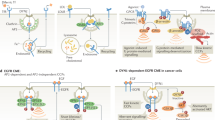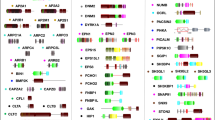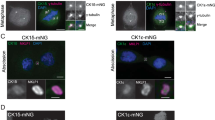Abstract
Endocytosis is a key cellular process, encompassing different entry routes and endocytic compartments. To what extent endocytosis is subjected to high-order regulation by the cellular signalling machinery remains unclear. Using high-throughput RNA interference and automated image analysis, we explored the function of human kinases in two principal types of endocytosis: clathrin- and caveolae/raft-mediated endocytosis. We monitored this through infection of vesicular stomatitis virus, simian virus 40 and transferrin trafficking, and also through cell proliferation and apoptosis assays. Here we show that a high number of kinases are involved in endocytosis, and that each endocytic route is regulated by a specific kinase subset. Notably, one group of kinases exerted opposite effects on the two endocytic routes, suggesting coordinate regulation. Our analysis demonstrates that signalling functions such as those controlling cell adhesion, growth and proliferation, are built into the machinery of endocytosis to a much higher degree than previously recognized.
This is a preview of subscription content, access via your institution
Access options
Subscribe to this journal
Receive 51 print issues and online access
$199.00 per year
only $3.90 per issue
Buy this article
- Purchase on SpringerLink
- Instant access to full article PDF
Prices may be subject to local taxes which are calculated during checkout





Similar content being viewed by others
References
Conner, S. D. & Schmid, S. L. Regulated portals of entry into the cell. Nature 422, 37–44 (2003)
Di Fiore, P. P. & De Camilli, P. Endocytosis and signaling. an inseparable partnership. Cell 106, 1–4 (2001)
Gonzalez-Gaitan, M. Signal dispersal and transduction through the endocytic pathway. Nature Rev. Mol. Cell Biol. 4, 213–224 (2003)
Miaczynska, M., Pelkmans, L. & Zerial, M. Not just a sink: endosomes in control of signal transduction. Curr. Opin. Cell Biol. 16, 400–406 (2004)
Carpenter, A. E. & Sabatini, D. M. Systematic genome-wide screens of gene function. Nature Rev. Genet. 5, 11–22 (2004)
Manning, G., Whyte, D. B., Martinez, R., Hunter, T. & Sudarsanam, S. The protein kinase complement of the human genome. Science 298, 1912–1934 (2002)
Lucocq, J., Warren, G. & Pryde, J. Okadaic acid induces Golgi apparatus fragmentation and arrest of intracellular transport. J. Cell Sci. 100, 753–759 (1991)
Simonsen, A., Wurmser, A. E., Emr, S. D. & Stenmark, H. The role of phosphoinositides in membrane transport. Curr. Opin. Cell Biol. 13, 485–492 (2001)
Nguyen, C. & Bibb, J. A. Cdk5 and the mystery of synaptic vesicle endocytosis. J. Cell Biol. 163, 697–699 (2003)
Mellman, I. Endocytosis and molecular sorting. Annu. Rev. Cell Dev. Biol. 12, 575–625 (1996)
Helenius, A., Kartenbeck, J., Simons, K. & Fries, E. On the entry of Semliki forest virus into BHK-21 cells. J. Cell Biol. 84, 404–420 (1980)
Smith, A. E. & Helenius, A. How viruses enter animal cells. Science 304, 237–242 (2004)
Sieczkarski, S. B. & Whittaker, G. R. Differential requirements of rab5 and rab7 for endocytosis of influenza and other enveloped viruses. Traffic 4, 333–343 (2003)
Kartenbeck, J., Stukenbrok, H. & Helenius, A. Endocytosis of simian virus 40 into the endoplasmic reticulum. J. Cell Biol. 109, 2721–2729 (1989)
Anderson, H. A., Chen, Y. & Norkin, L. C. Bound simian virus 40 translocates to caveolin-enriched membrane domains, and its entry is inhibited by drugs that selectively disrupt caveolae. Mol. Biol. Cell 7, 1825–1834 (1996)
Stang, E., Kartenbeck, J. & Parton, R. G. Major histocompatibility complex class I molecules mediate association of SV40 with caveolae. Mol. Biol. Cell 8, 47–57 (1997)
Pelkmans, L., Kartenbeck, J. & Helenius, A. Caveolar endocytosis of simian virus 40 reveals a new two-step vesicular-transport pathway to the ER. Nature Cell Biol. 3, 473–483 (2001)
Damm, E.-M. et al. Clathrin and caveolin-1 independent endocytosis: entry of simian virus 40 into cells devoid of caveolae. J. Cell Biol. 168, 477–488 (2005)
Razani, B. & Lisanti, M. P. Caveolins and caveolae: molecular and functional relationships. Exp. Cell Res. 271, 36–44 (2001)
Lu, Z., Ghosh, S., Wang, Z. & Hunter, T. Downregulation of caveolin-1 function by EGF leads to the loss of E-cadherin, increased transcriptional activity of β-catenin, and enhanced tumor cell invasion. Cancer Cell 4, 499–515 (2003)
Di Guglielmo, G. M., Le Roy, C., Goodfellow, A. F. & Wrana, J. L. Distinct endocytic pathways regulate TGF-beta receptor signalling and turnover. Nature Cell Biol. 5, 410–421 (2003)
Elbashir, S. M. et al. Duplexes of 21-nucleotide RNAs mediate RNA interference in cultured mammalian cells. Nature 411, 494–498 (2001)
Kirchhausen, T. Clathrin. Annu. Rev. Biochem. 69, 699–727 (2000)
Simonsen, A. et al. EEA1 links PI(3)K function to Rab5 regulation of endosome fusion. Nature 394, 494–498 (1998)
Stahlhut, M. & van Deurs, B. Identification of filamin as a novel ligand for caveolin-1: evidence for the organization of caveolin-1-associated membrane domains by the actin cytoskeleton. Mol. Biol. Cell 11, 325–337 (2000)
Tsai, B. et al. Gangliosides are receptors for murine polyoma virus and SV40. EMBO J. 22, 4346–4355 (2003)
Rothman, J. E. Mechanisms of intracellular protein transport. Nature 372, 55–63 (1994)
Pelkmans, L., Burli, T., Zerial, M. & Helenius, A. Caveolin-stabilized membrane domains as multifunctional transport and sorting devices in endocytic membrane traffic. Cell 118, 767–780 (2004)
Eisen, M. B., Spellman, P. T., Brown, P. O. & Botstein, D. Cluster analysis and display of genome-wide expression patterns. Proc. Natl Acad. Sci. USA 95, 14863–14868 (1998)
Zerial, M. & McBride, H. Rab proteins as membrane organizers. Nature Rev. Mol. Cell Biol. 2, 107–117 (2001)
Pelkmans, L. & Zerial, M. Kinase-regulated quantal assemblies, kiss-and-run and recycling of caveolae. Nature (submitted)
Wary, K. K., Mariotti, A., Zurzolo, C. & Giancotti, F. G. A requirement for caveolin-1 and associated kinase Fyn in integrin signaling and anchorage-dependent cell growth. Cell 94, 625–634 (1998)
del Pozo, M. A. et al. Integrins regulate Rac targeting by internalization of membrane domains. Science 303, 839–842 (2004)
Pelkmans, L., Puntener, D. & Helenius, A. Local actin polymerization and dynamin recruitment in SV40-induced internalization of caveolae. Science 296, 535–539 (2002)
Wellbrock, C., Karasarides, M. & Marais, R. The RAF proteins take centre stage. Nature Rev. Mol. Cell Biol. 5, 875–885 (2004)
Schlessinger, J. Cell signaling by receptor tyrosine kinases. Cell 103, 211–225 (2000)
Davis, R. J. Signal transduction by the JNK group of MAP kinases. Cell 103, 239–252 (2000)
Warren, G., Davoust, J. & Cockcroft, A. Recycling of transferrin receptors in A431 cells is inhibited during mitosis. EMBO J. 3, 2217–2225 (1984)
Tuomikoski, T., Felix, M. A., Doree, M. & Gruenberg, J. Inhibition of endocytic vesicle fusion in vitro by the cell-cycle control protein kinase cdc2. Nature 342, 942–945 (1989)
Minshall, R. D., Sessa, W. C., Stan, R. V., Anderson, R. G. & Malik, A. B. Caveolin regulation of endothelial function. Am. J. Physiol. Lung Cell. Mol. Physiol. 285, L1179–L1183 (2003)
Sharma, D. K. et al. Selective stimulation of caveolar endocytosis by glycosphingolipids and cholesterol. Mol. Biol. Cell 15, 3114–3122 (2004)
Cavalli, V. et al. The stress-induced MAP kinase p38 regulates endocytic trafficking via the GDI:Rab5 complex. Mol. Cell 7, 421–432 (2001)
Woodman, P. G., Mundy, D. I., Cohen, P. & Warren, G. Cell-free fusion of endocytic vesicles is regulated by phosphorylation. J. Cell Biol. 116, 331–338 (1992)
Dubois, L., Lecourtois, M., Alexandre, C., Hirst, E. & Vincent, J. P. Regulated endocytic routing modulates wingless signaling in Drosophila embryos. Cell 105, 613–624 (2001)
Xue, L. & Lucocq, J. ERK2 signalling from internalised epidermal growth factor receptor in broken A431 cells. Cell. Signal. 10, 339–348 (1998)
Teis, D., Wunderlich, W. & Huber, L. A. Localization of the MP1–MAPK scaffold complex to endosomes is mediated by p14 and required for signal transduction. Dev. Cell 3, 803–814 (2002)
Di Guglielmo, G. M., Baass, P. C., Ou, W. J., Posner, B. I. & Bergeron, J. J. Compartmentalization of SHC, GRB2 and mSOS, and hyperphosphorylation of Raf-1 by EGF but not insulin in liver parenchyma. EMBO J. 13, 4269–4277 (1994)
Parton, R. G. Caveolae–from ultrastructure to molecular mechanisms. Nature Rev. Mol. Cell Biol. 4, 162–167 (2003)
Kholodenko, B. N. Four-dimensional organization of protein kinase signaling cascades: the roles of diffusion, endocytosis and molecular motors. J. Exp. Biol. 206, 2073–2082 (2003)
Schnell, M. J., Buonocore, L., Whitt, M. A. & Rose, J. K. The minimal conserved transcription stop-start signal promotes stable expression of a foreign gene in vesicular stomatitis virus. J. Virol. 70, 2318–2323 (1996)
Macé, G., Miaczynska, M., Zerial, M. & Nebreda, A. R. Phosphorylation of EEAI by p38MAP kinase regulates m opioid receptor endocytosis. EMBO J. (submitted)
Acknowledgements
We thank F. Halley and A. Kroenke for experimental assistance, J. Rose for rVSV, and G. Kochs for hybridomas expressing anti-Tag antibodies. I. Baines (Biopolis Dresden Consultants GmbH), D. Dorris (Ambion Inc.), C. Echeverri (Cenix Bioscience GmbH), R. Günther (Evotec Technologies GmbH) and M. Athelogou (Definiens AG) are acknowledged for making HT RNAi technologies and high-content, automated imaging and analysis technologies available. We thank F. Buchholz, C.-P. Heisenberg, M. Miaczynska, D. Meder, A. Schenck, A. Helenius and K. Simons for discussions and critical reading of the manuscript. L.P. would like to thank A. Helenius for continuous support. This work was supported by grants from the Max Planck Society ‘RNAi interference’ initiative and the Bundesministerium für Bildung und Forschung. L.P. is a Marie Curie fellow.Author Contributions L.P. and M.Z. conceived the experimental idea. L.P. carried out the experiments with help from E.F., H.G. and M.H. Data analysis was carried out by L.P., B.H. and M.Z. L.P., E.K. and M.Z. together with I. Baines conceived and set up the HT-TDS and financed the project. L.P. and M.Z. wrote the manuscript.
Author information
Authors and Affiliations
Corresponding author
Ethics declarations
Competing interests
Reprints and permissions information is available at npg.nature.com/reprintsandpermissions. The authors declare no competing financial interests.
Supplementary information
Supplementary Figure S1
HT genome-wide analysis of human genes in infectious virus entry. (JPG 351 kb)
Supplementary Figure S2
Hierarchical phenotype clustering of kinases in functional groups. (JPG 596 kb)
Supplementary Table S1
Screening results from all 590 kinases (XLS 167 kb)
Supplementary Table S2
Screening results from 50 random genes (XLS 28 kb)
Supplementary Table S3
Hierarchical clustering of RIIs and phenotypic profiles. (XLS 943 kb)
Supplementary Legends
Legends to accompany the above Supplementary Tables and Supplementary Figures. (DOC 41 kb)
Rights and permissions
About this article
Cite this article
Pelkmans, L., Fava, E., Grabner, H. et al. Genome-wide analysis of human kinases in clathrin- and caveolae/raft-mediated endocytosis. Nature 436, 78–86 (2005). https://doi.org/10.1038/nature03571
Received:
Accepted:
Published:
Issue Date:
DOI: https://doi.org/10.1038/nature03571



